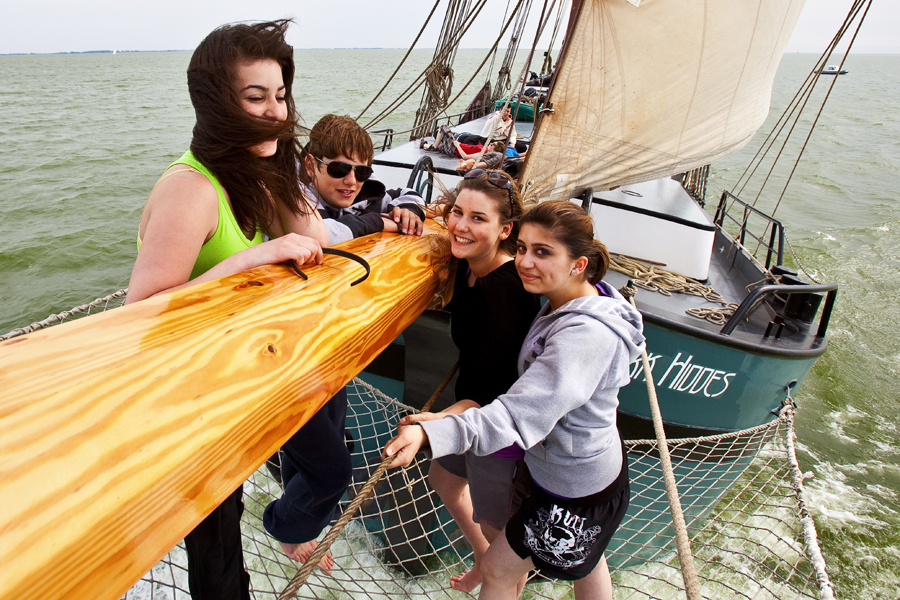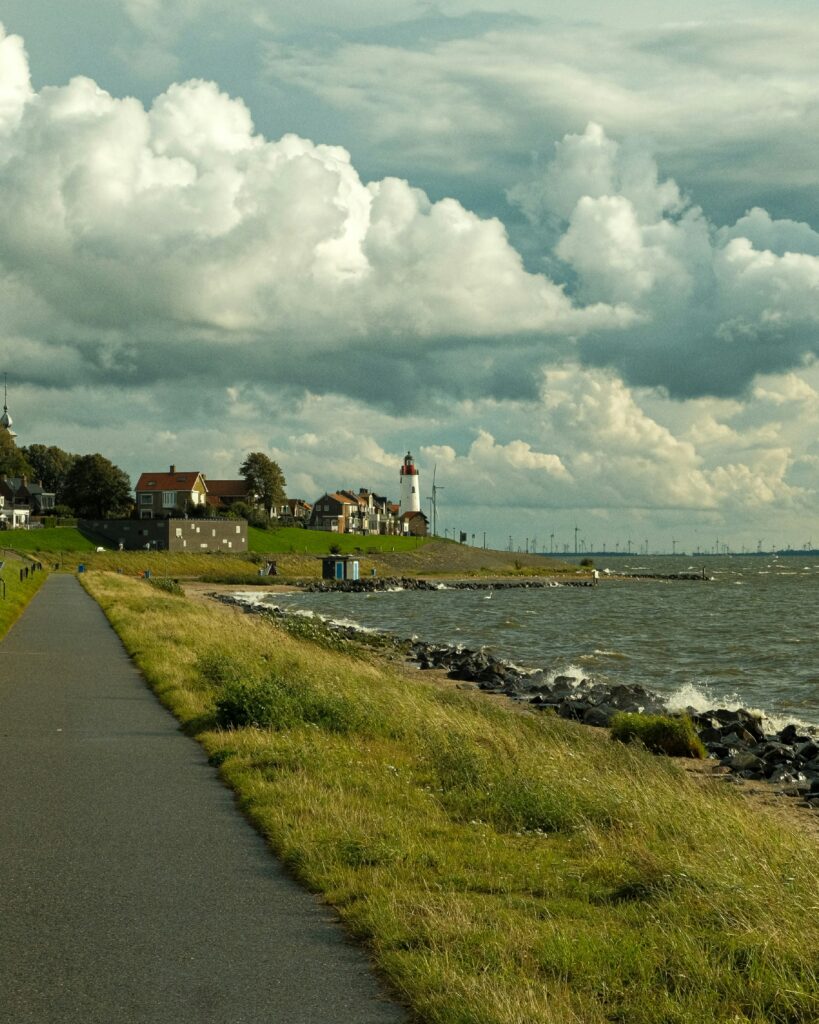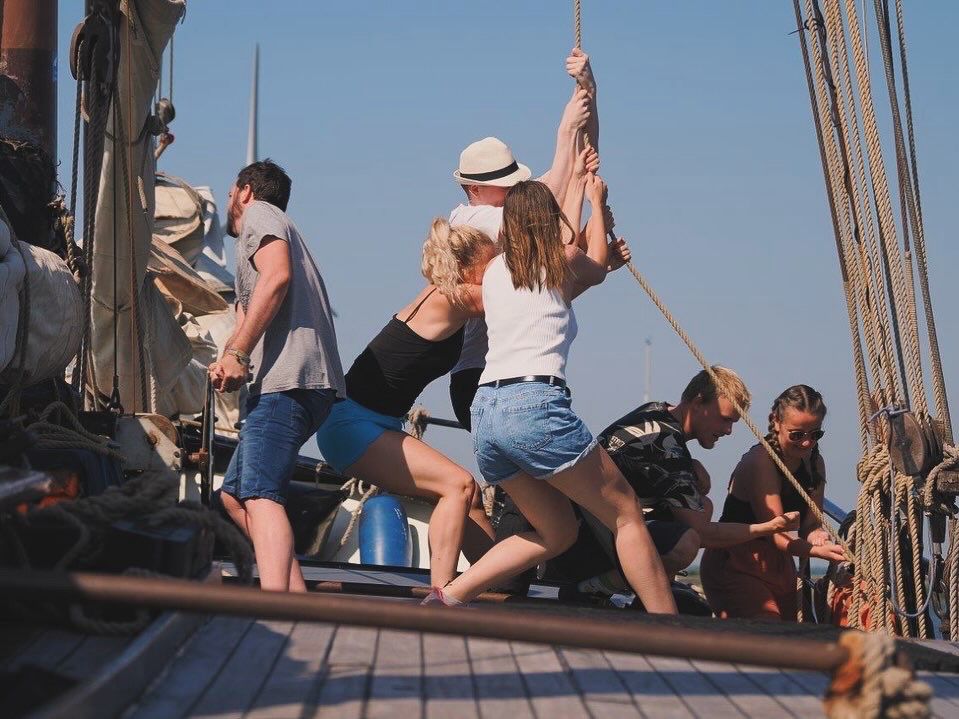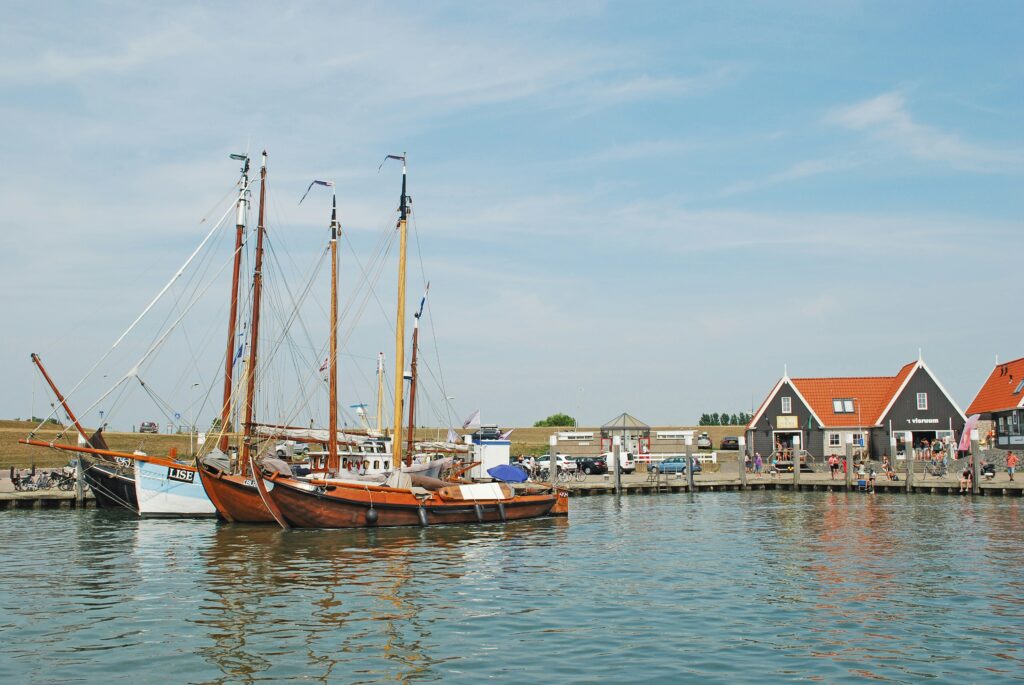Report of a wonderful sailing trip, Sept. 2025
For five days, we will be together on board the beautiful traditional sailing ship. This week, we will sail together around what was once the old Zuiderzee, but is now called the IJsselmeer. Nearly 100 years ago, construction began on the Afsluitdijk. After the dike was completed, the once unpredictable Zuiderzee slowly turned into a freshwater lake.
De Zuiderzee gaf en de Zuiderzee nam. Dat hebben ook alle stadjes aan de rand van de zee eeuwenlang gemerkt. Overstromingen, stormen waardoor het land en soms een stuk stad wegsloeg, nieuwe zandbanken waardoor de scheepvaart de haven niet meer kon bereiken. Maar sinds de aanleg van de afsluitdijk werd het makkelijker. De eeuwenoude havenstadjes kregen rust. Het werden in onze ogen, één voor één prachtige en bezienswaardige steden. Waar je de historie van de zeehaven, de visserij en de handel nog steeds aan kunt zien en proeven.
This midweek, we are sailing on an old cargo ship. It was once built to carry freight under sail—often without a motor back then—the trucks of the past. Now, for decades, this ship has been sailing around with groups of people. It travels from town to town, offering comfortable, rustic yet modern accommodation in what was once the empty cargo hold.
Monday — Cast off the lines
The wind is in our favor—a southwesterly breeze, force three to four. You couldn’t wish for better on the first day. After breakfast, the crew carefully explains what we are going to do, what we must do, and also what we shouldn’t do. Together, under the guidance of the deckhand, we hoist the sails, which seem immense to us. We wave goodbye to Enkhuizen, our port of departure, where, after five days of wandering over the water, we will return to shore—hopefully with plenty of sailing experience, new adventures, knowledge of the towns, and true sea legs.
While hoisting the sails, I wonder, ‘How did the sailors of the past manage this on these ships? They were only three or four people on board and still handled these heavy sails…’ For us, it isn’t too hard, since there are many of us—and many hands make light work.
On course to Urk
After about an hour of sailing, our lunch destination comes into view: Urk. The former island now lies on the edge of the Noordoostpolder. Urk remained an island until 1939, and you can clearly see that. The closer we get, the more recognizable it becomes. Urk rises as a bump in the otherwise straight and even dike of the polder, with its white lighthouse topped by a red cap standing prominently at the center. This distinctive lighthouse still shines its bright light every night over Urk and the IJsselmeer.
Together we lower the sails and sail into the harbor of Urk. Only a few working fishing boats remain in the large fishing harbor. Most of the vessels moored there are historical ships, no longer used for professional fishing. Urk is known for its fishing industry, but today’s fishing boats are so large and advanced that they operate only on the open sea and stay in the major seaports along the North Sea coast. Still, the old fishing traditions are clearly visible in the small fishermen’s cottages and the many fish restaurants around the harbor. The harbor of Urk is a lively, cheerful place—old houses with orange roofs stand cozily around the quay. Of course, we have some fish there; that’s something we simply can’t miss.


To Lemmer, past the wind turbines
After lunch, we leave the harbor and set sail again. We head toward Lemmer, passing an endless row of wind turbines. These mighty towers turn their blades round and round, providing green energy for many. It may not be particularly beautiful, but it is certainly impressive—the long, straight dike lined with these enormous windmills.
We’re enjoying the sailing—the rippling water and the beautiful Dutch skies. The dike and the windmills pass by, and before long we reach the Rotterdammerhoek, the entrance to the bay of Lemmer. The skipper tells us that this stretch of dike was built using rubble that was transported from Rotterdam after the bombing during the war. It leaves you silent for a moment.
The first thing we see of Lemmer, at the end of the bay, is the beach—a tempting sight on this beautiful day. We moor at a jetty next to an old lock. It’s bustling with activity there, and also beyond, in the old harbor basin of Lemmer. In the late afternoon, we stroll through the historic town center. Lemmer is a lively little town, perfect for some shopping or relaxing on a terrace, with plenty of charming shops, streets, and cafés.
As evening falls, we have dinner on board, and after a relaxed and pleasant evening with a beer and a board game, we head to our cabin, content, to sleep soundly on the gently rocking ship.
Tuesday — Lock day
The next morning, we all have breakfast outside on deck, and during breakfast we pass through the so-called ‘bayonet lock’ (with gates not directly opposite each other) of Lemmer, entering Friesland. How wonderful—a breakfast with a changing view! We motor straight through Lemmer, where the charming little houses stand right by the water and boats are moored everywhere. (Respect to the skipper, who skillfully guided us and the ship through this narrow waterway.)
Sailing through the Frisian countryside
When we reach a lake—the spot where we can hoist the sails again—breakfast and coffee are long finished. Time to raise the sails. We sail peacefully through Friesland, past reed beds, meadows with cows, and farmhouses along the water. We glide along a canal cutting through the land. I wonder, was it like this in the old days too, when sailing cargo ships passed through here?
We sail past a small town, an island, a campsite, a bridge, and even over an aqueduct. We adjust the sails and wave to the many other boats on the water. Then suddenly, late in the afternoon, the skipper calls out: ‘We’re here!’ There lies Stavoren—that’s where we’ll spend the night. We pass through another lock, and just like that, we’re back on the IJsselmeer. Having sailed straight through Friesland, we’re once again on the great lake. We moor in the old seaport of Stavoren—the harbor town with three working locks.
Evening in Stavoren
This harbor town is a place where time seems to move slowly; the people who live here stroll about unhurriedly. There are a few small shops, a supermarket, and the little statue of ‘Het Vrouwtje van Stavoren’—the well-known legend of the merchant’s wife who always wanted more and in the end became a beggar. It’s a small but charming town, full of harbors and boats. There are little canals and bridges, old houses by the harbor from days gone by, and new houses painted in cheerful colors—reminiscent of Denmark.
In the harbor, many more ships are moored—just like the one we’re sailing on—also with groups of people aboard. In the evening, we sit on deck in the setting sun, enjoying the beautiful view and chatting pleasantly with our neighbors. They too are sailing a round trip and will head to the Wadden Sea tomorrow. Not us—we will make the great crossing over the IJsselmeer, back to the North Holland coast.


Wednesday — Rocking day
The wind is picking up
Wednesday suddenly brings very different weather. The wind has ‘come up’—it’s blowing hard. The skipper and his mate walk calmly across the deck, preparing for the voyage and putting in the first reef. We put on an extra sweater and, after breakfast, sail out of the harbor. With the stronger wind, waves have also begun to form. The ship crashes into a wave, sending a fan of water spraying from the bow—magnificent!
From Stavoren, Medemblik lies to the west. And with today’s westerly wind, force five, we’ll have to tack—zigzagging against the wind. The ship and crew are clearly enjoying themselves—the wind, the challenge, the speed of the vessel. And we, as a group, love it too; after a few calm days, it’s great to really get to work. Together, we steer the ship through the wind and waves until we finally reach the harbor of Medemblik. There’s not a wave in sight there—it’s the lee shore, the side from which the wind is blowing, and so the water is calm.
Arrival in historic Medemblik
We sail between two piers into the harbor of Medemblik, passing right by a beautiful castle—the castle of King Radboud. At the end of the harbor, we moor in what feels like a park. We’re lying under willow trees, right in the middle of the town. Bigger than Stavoren, smaller than Lemmer, but the oldest town in West Friesland—the part of the province of North Holland where we are now. A confusing name when you’ve just come from Friesland! We want to learn more about it, and the office of Rederij van Linschoten arranged a guide to give us a tour of the town the next morning (for which we are most grateful and appreciative).
Thursday it’s BBQ day
The next morning, we set out, and the guide talks enthusiastically about the rich history of the old town. We wander crisscross through the small city, listening to stories about the various gabled houses, the Bonifatius Church, the statue of the men by the harbor, and the castle of King Radboud.
In the early afternoon, we hoist the sails together once more and sail southwest toward Enkhuizen—passing the Lighthouse of De Ven on our way. A cheerful and plentiful barbecue on the mid-deck completes the day
Friday — Museum day
On the final day of the week, we stay in Enkhuizen. We sail from the outer jetty near the ‘Rommelhoek’ to the museum harbor and get a prime spot for a visit to the Zuiderzee Museum. Enkhuizen itself is a bit like a small version of Amsterdam—charming little houses by the water, interspersed with grand buildings reminiscent of Amsterdam’s canal houses. Streets with curious names, such as ‘The Three Green Acorns’ and ‘Between Hell and Purgatory,’ hint at the town’s long history.
All in all
We have sailed a beautiful voyage across the IJsselmeer:
- Along the way, we enjoyed the nature, felt the weather and the wind — an altogether wonderful experience.
- In the towns, we discovered the rich history, took walks, did some shopping, and relaxed on a terrace
- A holiday not soon to be forgotten. And so easy: one booking and everything was arranged for us — bed, food, activities, and good company. How convenient!
What would you like to experience? Rederij van Linschoten is happy to organize your sailing holiday with a skipper along the beautiful towns of the IJsselmeer, the Markermeer, or the UNESCO World Heritage Wadden Sea!
